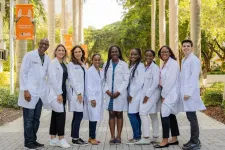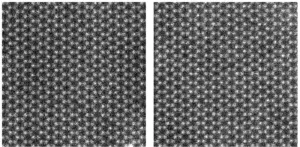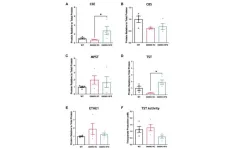(Press-News.org) Fine particulate matter comes from wood burning, power generation, motor vehicles and other combustion sources that emit tiny particles into the air. At only 2.5 micrometers or smaller, these particles are small enough to be inhaled and cause lasting damage to the heart and lungs. Known as PM2.5, exposure to these particles is a leading mortality risk factor in India and the surrounding region of South Asia.
A new study by researchers in Randall Martin’s lab in the McKelvey School of Engineering at Washington University in St. Louis evaluated the contribution of various emission sectors and fuels to PM2.5 mass for 29 states in India and six surrounding countries: Pakistan, Bangladesh, Nepal, Bhutan, Sri Lanka and Myanmar.
The results, published July 7 in Environmental Science & Technology, identify primary organics — organic particles emitted directly into the atmosphere from various sources — as the main drivers of high concentrations of PM2.5 over South Asia. The paper also illuminates potential pathways to reduce PM2.5 mass and improve population health across South Asia.
“Countries in South Asia have substantial emissions and associated air pollution and mortality burden,” said first author Deepangsu Chatterjee, a doctoral student in energy, environmental & chemical engineering in the McKelvey School of Engineering. “Our study shows that over 1 million deaths in South Asia attributable to ambient PM2.5 in 2019 were primarily from residential combustion, industry and power generation. Solid biofuel is the leading combustible fuel contributing to the PM2.5-attributable mortality, followed by coal and oil and gas.”
“Air pollution, both indoors and outdoors, is the leading risk factor for death in South Asia,” said co-author Michael Brauer, professor at the Institute for Health Metrics and Evaluation at the University of Washington and the University of British Columbia. “Understanding the major contributing sources is a critical first step towards management of this serious problem.”
A major challenge in evaluating the impacts of PM2.5 is understanding how it is produced and distributed over time. Chatterjee and Martin, the Raymond R. Tucker Distinguished Professor in McKelvey Engineering, combined global emission inventories, satellite-derived fine surface particulate matter estimates and state-of-the-art global scale modeling capabilities to develop regional simulations. They also accounted for long-range transport to understand how different emission sectors and fuels contributed to PM2.5 and associated mortality rates.
“Advances in modeling atmospheric composition with constraints from satellite remote sensing enabled our assessment of the sources of PM2.5 across South Asia,” Martin said. “That helped draw our attention to large contributions from burning biofuel and coal.”
Chatterjee also noted that PM2.5 mass composition in South Asia is driven by primary organics across major contributing sectors. The team’s PM2.5 composition analysis can be particularly useful to develop mitigation strategies associated with particular species.
A few other notable features include high contribution from coal in central and eastern India, higher household air pollution in north-east and central India, biofuel contributions in Bangladesh and open fires in Myanmar.
“This study shows that the air pollution problem in South Asia is not just an urban scale problem, so policies targeted at urban scale development will not be enough to mitigate the national level PM2.5 exposure,” Chatterjee said.
Chatterjee, Martin and their co-authors suggest several strategies for future interventions throughout South Asia, including policies encouraging the replacement of traditional fuel sources with sustainable sources of energy.
“Policies in India in the past five to 10 years have worked toward identifying and improving air pollution concerns and associated health burden and mortality risks. Seeing these policies be effective is motivating for the South Asian population to keep moving the needle and develop strategic policies to curb the growth of air pollution,” Chatterjee said. “Our paper provides detailed sector-, fuel- and composition-based information for different states in India along with surrounding countries, which could be useful for local policymakers to eliminate PM2.5 sources associated with their specific region.”
Chatterjee D, McDuffie EE, Smith SJ, Bindle L, van Donkelaar A, Hammer MS, Venkataraman C, Brauer M, Martin RV. Source contributions to fine particulate matter and attributable mortality in India and the surrounding region. Environmental Science & Technology, July 7, 2023. DOI: https://pubs.acs.org/doi/10.1021/acs.est.2c07641
This work was supported by NASA (80NSSC21K0508) and the Health Effects Institute, an organization jointly funded by the U.S. Environmental Protection Agency (R-82811201) and certain motor vehicle manufacturers.
Originally published by the McKelvey School of Engineering.
END
Paths for reducing harmful air pollution in South Asia identified
2023-07-11
ELSE PRESS RELEASES FROM THIS DATE:
Zoonotic researcher receives ORAU Ralph E. Powe Junior Faculty Enhancement Award
2023-07-11
Daniel Becker, Ph.D., an assistant professor of Biology in the Dodge Family College of Arts and Sciences, has received an Oak Ridge Associated Universities Ralph E. Powe Junior Faculty Enhancement Award for his continued research on bat migration in western Oklahoma.
“We’re studying migratory Mexican free-tailed bats and the pathogens they might carry that are possible threats to human or wildlife health,” Becker said. “This award allows us to purchase the microchips we implant in the bats and ...
Cancer disparities: Sylvester researchers, collaborators seek answers to prostate, breast cancer among people of African ancestry
2023-07-11
MIAMI, FLORIDA (July 11, 2023) – “Please, please do it (cancer screening), if not for yourself, then for the next generation. We need to see the day when we end cancer.”
Those are the impassioned words of Charinus Johnson-Davis, who was diagnosed with breast cancer a dozen years ago but is now cancer-free after a double-mastectomy and 28 rounds of chemotherapy plus radiation. She is on a mission to help address cancer disparities affecting Black women and men, and is one of the first to enroll in the African Cancer Genome Registry, a new study at Sylvester Comprehensive Cancer ...
AGS supports CMS decision to require real-world data for monoclonal antibodies
2023-07-11
New York (July 11, 2023) — The American Geriatrics Society (AGS) supports the recently announced decision from the Centers for Medicare and Medicaid Services (CMS) to require the collection of real-world information via a registry to study monoclonal antibodies directed against amyloid for the treatment of Alzheimer's disease. This decision applies to monoclonal antibodies that receive traditional approval from the Food and Drug Administration (FDA). Currently, lecanemab (trade name ...
GSA Connects 2023: A premier international scientific meeting
2023-07-11
11 July 2023
The Geological Society of America
Release no. 23-25
Contact: Justin Samuel
+1-303-357-1026
jsamuel@geosociety.org
For immediate release
GSA Connects 2023: A Premier International Scientific Meeting
The Geological Society of America visits Pittsburgh
Boulder, Colo., USA: Media registration is open now for The
Geological Society of America’s Connects 2023
meeting, to be held 15–18 October 2023 at the David L Lawrence Convention
Center (1000 Fort Duquesne Blvd) in Pittsburgh, Pennsylvania, USA. The
organizing committee is pleased to be planning a dynamic meeting centered
around ...
Generative AI ‘fools’ scientists with artificial data, bringing automated data analysis closer
2023-07-11
The same AI technology used to mimic human art can now synthesize artificial scientific data, advancing efforts toward fully automated data analysis.
Researchers at the University of Illinois Urbana-Champaign have developed an AI that generates artificial data from microscopy experiments commonly used to characterize atomic-level material structures. Drawing from the technology underlying art generators, the AI allows the researchers to incorporate background noise and experimental imperfections into the generated ...
Satisfaction with online dating app depends on what you’re looking for
2023-07-11
With an estimated 75 million active users each month, Tinder is the most popular dating app in the world. But a new study by Stanford Medicine researchers and collaborators has found, surprisingly - though perhaps not to users of the app - that many users are not swiping for dates.
In a survey of more than a thousand Tinder users, half said they were not interested in meeting offline, and nearly two-thirds were already married or "in a relationship."
In fact, the psychological motivations behind people's use of the app varied widely and had a strong influence on their satisfaction with the app and the dates it led to, according to the study published June 23 ...
University of Illinois study finds turning food waste into bioenergy can become a profitable industry
2023-07-11
URBANA, Ill. — Food waste is a major problem around the world. In the United States, an estimated 30 to 40% of edible food is lost or wasted, costing billions of dollars each year. One potential solution is to divert food waste from landfills to renewable energy production, but this isn’t done on a large scale anywhere. A new study from the University of Illinois Urbana-Champaign investigates the feasibility of implementing energy production from food waste in the state of Illinois.
“We have a large amount of organic waste in the U.S., which eventually enters landfills and emits greenhouse gasses. However, this material ...
Hepatic hydrogen sulfide levels are reduced in mouse model of progeria
2023-07-11
“To date, no studies have directly measured [hydrogen sulfide] production in Hutchinson-Gilford Progeria Syndrome [...]”
BUFFALO, NY- July 11, 2023 – A new research paper was published in Aging (listed by MEDLINE/PubMed as "Aging (Albany NY)" and "Aging-US" by Web of Science) Volume 15, Issue 12, entitled, “Hepatic hydrogen sulfide levels are reduced in mouse model of Hutchinson-Gilford progeria syndrome.”
Hutchinson-Gilford progeria syndrome (HGPS) is a rare ...
Missing a rare cause of hereditary cancer
2023-07-11
New research from Cedars-Sinai Cancer investigators could warrant reconsideration of current screening guidelines to include a poorly recognized cause of Lynch syndrome, the most common cause of hereditary colorectal and endometrial cancers. Their study, published today in the JNCCN—Journal of the National Comprehensive Cancer Network, concluded that the guidelines leave a significant number of patients undiagnosed.
“When patients with Lynch syndrome—whose first cancers generally appear at an early age—aren’t diagnosed promptly, they don’t get appropriate follow-up or surveillance,” said Megan Hitchins, ...
U of M Medical School receives DARPA award to develop detection tools for early symptoms of depression, psychosis and suicidality
2023-07-11
MINNEAPOLIS/ST. PAUL (07/11/2023) — Researchers at the University of Minnesota Medical School recently received a four-year award from the Defense Advanced Research Projects Agency’s (DARPA’s) Neural Evidence Aggregation Tool program. The goal of their project— titled Fast, Reliable Electrical Unconscious Detection (FREUD)—is to develop tools to better detect early symptoms of depression, psychosis and suicidality, with the intent that treatment can be started as early in a condition’s trajectory as possible.
“It’s exactly those early moments when getting someone therapy or mental health services could save their life or ...







